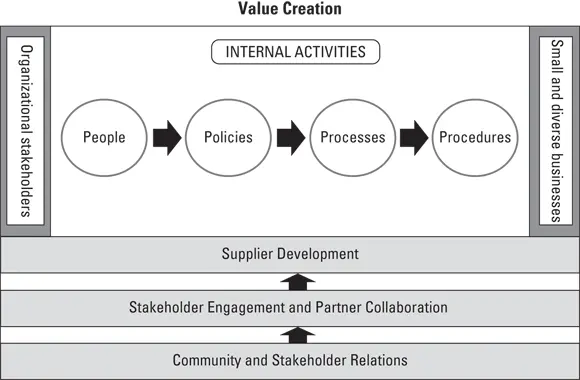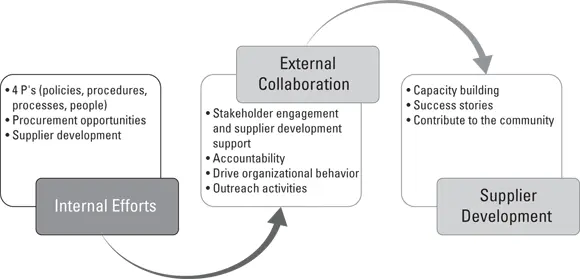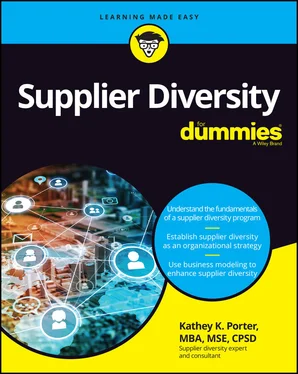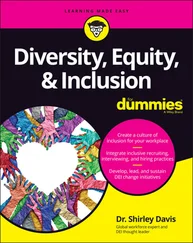Kathey K. Porter - Supplier Diversity For Dummies
Здесь есть возможность читать онлайн «Kathey K. Porter - Supplier Diversity For Dummies» — ознакомительный отрывок электронной книги совершенно бесплатно, а после прочтения отрывка купить полную версию. В некоторых случаях можно слушать аудио, скачать через торрент в формате fb2 и присутствует краткое содержание. Жанр: unrecognised, на английском языке. Описание произведения, (предисловие) а так же отзывы посетителей доступны на портале библиотеки ЛибКат.
- Название:Supplier Diversity For Dummies
- Автор:
- Жанр:
- Год:неизвестен
- ISBN:нет данных
- Рейтинг книги:4 / 5. Голосов: 1
-
Избранное:Добавить в избранное
- Отзывы:
-
Ваша оценка:
- 80
- 1
- 2
- 3
- 4
- 5
Supplier Diversity For Dummies: краткое содержание, описание и аннотация
Предлагаем к чтению аннотацию, описание, краткое содержание или предисловие (зависит от того, что написал сам автор книги «Supplier Diversity For Dummies»). Если вы не нашли необходимую информацию о книге — напишите в комментариях, мы постараемся отыскать её.
Supplier Diversity For Dummies,
Supplier Diversity For Dummies
Supplier Diversity For Dummies — читать онлайн ознакомительный отрывок
Ниже представлен текст книги, разбитый по страницам. Система сохранения места последней прочитанной страницы, позволяет с удобством читать онлайн бесплатно книгу «Supplier Diversity For Dummies», без необходимости каждый раз заново искать на чём Вы остановились. Поставьте закладку, и сможете в любой момент перейти на страницу, на которой закончили чтение.
Интервал:
Закладка:
For example, you can divide the production process into smaller sub-processes, such as preparing the batter, making the icing, adding toppings or designs, baking the cakes, and packing and shipping. Each of these sub-processes has its own sub-processes (all the ingredients needed, ideal storage conditions). You keep repeating these steps until you reach the lowest level of the process, or activities, to get a finalized and detailed plan of all the company’s processes.
The same principles make up the supplier diversity management model. When you’re working on one aspect, or something that you’re more comfortable with, focusing on just that one element and neglecting others is easy. But if you don’t realize the interconnectivity between each part, the process can be ineffective, inefficient, or both.
Figure 3-1 illustrates the supplier diversity management process.
Each of these functions is interconnected, and they work together to create a push and pull effect to reach the goal of creating value for the organization and the community. External community stakeholders have an interest in creating a strong small and diverse business community and can drive action. To do so, they may push organizations to ensure that small, diverse, and local business are able to compete and have opportunities to be considered for contract awards. They then pull information from these organizations to stay abreast of what’s happening and hold them accountable to comply.

FIGURE 3-1:The supplier diversity management process.
Organizations may create programs or adjust their program activities in response to this movement. They push information about their programs, upcoming opportunities, and results out to stakeholders, the small and diverse business community, and internal departments and senior leaders. After the program is in place, organizations work to develop small and diverse businesses so that departments are able to engage businesses that are ready and able to successfully perform on projects. The success of these businesses allows them to build sustainable businesses and remain viable contributors to the business community.
Introducing the Supplier Diversity Management (SDM) Model
Supplier diversity management focuses on building a full, holistic program that includes all the areas necessary — not just one or two aspects — to maximize benefits. The supplier diversity management (SDM) model is a guide that helps map out the key functions for any type of organization or agency looking to implement a full-scale supplier diversity program that achieves results and delivers value to the organization.
When you build a program that is in alignment with your organization’s goals and focuses — not just conducting activities or going through the motions but also adding value to the organization — guiding your actions toward meaningful activities becomes easier. The SDM model ensures that your internal and external activities and supplier development converge (see Figure 3-2), allowing you to deliver on this promise.

FIGURE 3-2:Supplier diversity interconnectivity.
Figure 3-3 illustrates how the SDM model works and how each aspect works together and complements the other.

FIGURE 3-3:Supplier diversity management model.
The internal process
Everything starts here. This part focuses on all your internal activities, your 4 P’s, your in-reach efforts, and your programs and determines the robustness of your program. It’s the heart of your supplier diversity efforts, but, like a human, your program needs more than a heart to function healthy and strong.
Many organizations have an “if we build it, they will come” approach, in that they think businesses will line up to do business with them if they create a program. In reality, the most qualified and capable firms are in high demand, especially in industries that don’t have many small or diverse businesses. These companies have the luxury of being very selective about who their partners are. They aren’t interested in processes that are cumbersome and unwelcoming, no matter who you are or how big your organization is. But entrepreneurship is alive and well. Every day, more people are deciding to pursue their dreams of owning a business. This boom creates many opportunities to show would-be entrepreneurs why you’re a good partner and that their next client is you.
The external process
This part may be two-fold:
External stakeholders: Whether they’re consumers, community leaders, business partners, or the small and diverse businesses themselves, external stakeholders can provide the motivation and push that organizations sometimes need in order to take action. As I discuss in Chapter 2, supplier diversity started in response to the social and economic inequality of the 1960s. Over the years, as it entered different phases, the shift was usually in response to some kind of external force. In fact, even the resurgence supplier diversity experienced in 2021 was a result of the racial and social unrest of 2020.External stakeholders are also resource partners in that they team up with an organization to deliver programs to small and diverse businesses, especially if the organization doesn’t have enough resources to fully devote to this function. Further, they’re prime partners (suppliers with a direct contract with the organization) that may provide subcontracting or other businesses partnering opportunities to small and diverse businesses.
Community outreach: Community outreach involves actively engaging in the community to scout and recruit companies to do business with your organization. The supplier diversity industry has done a great job of creating opportunities to connect small and diverse businesses to decision makers. Before the COVID-19 pandemic, on any given day in any city, there was no shortage of events in which small and diverse businesses participated.
The supplier development process
Through external collaborations (see the preceding section), organizations realized that they could provide additional support in a way that was cost effective yet still impactful. It also engaged their prime partners and encouraged them to adopt their own supplier diversity efforts providing additional opportunities for small and diverse businesses. This relationship gave rise to the importance of supplier development.
As the name indicates, the focus is on development — proactively creating a pipeline of small and diverse businesses ready to work with your organization. As organizations become more intentional about supplier diversity and allocate more time and professional resources to their programs, they have to look beyond just spend analytics. Supplier development allows you to do that and has become one of the most important facets of the model. Investing in small and diverse businesses not only prepares them for the rigors of doing business with your organization, but it also primes them for contract opportunities with other institutions. This boost helps build their capacity, which is vital for long-term growth and entrepreneurial sustainability.
Supplier development is probably the process that’s missing from most supplier development programs. Supplier development comes in many forms, from informal efforts such as workshops and networking events to more structured programs including mentoring programs, accelerators, and matchmaking. What you decide to do depends on the stage of your program, your budget and resources, your organization’s goals, and what makes sense for your organization.
Читать дальшеИнтервал:
Закладка:
Похожие книги на «Supplier Diversity For Dummies»
Представляем Вашему вниманию похожие книги на «Supplier Diversity For Dummies» списком для выбора. Мы отобрали схожую по названию и смыслу литературу в надежде предоставить читателям больше вариантов отыскать новые, интересные, ещё непрочитанные произведения.
Обсуждение, отзывы о книге «Supplier Diversity For Dummies» и просто собственные мнения читателей. Оставьте ваши комментарии, напишите, что Вы думаете о произведении, его смысле или главных героях. Укажите что конкретно понравилось, а что нет, и почему Вы так считаете.












